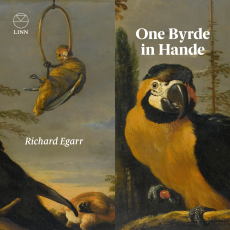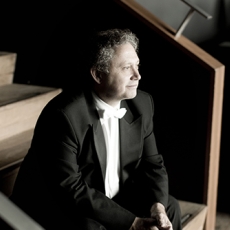Richard Egarr - One Byrde in Hande - Early Music Review
The versatile musician Richard Egarr contributes to what is something of a succession of distinguished recordings devoted to keyboard music by Byrd. Only Pavana Lachrymae and the Praeludium and Fancie overlap with the selection on Colin Tilney’s choice of Byrd which I reviewed only recently for EMR. The disc under review here is another well-chosen anthology, wandering slightly further off piste than Tilney in including the exquisite pavan and galliard pair in A minor, BK 16. Here, the good news is that, notwithstanding Egarr’s assertion in his booklet notes that the attribution is insecure, on the contrary the attribution is as safe as it can be for a piece from this period that does not survive in a source directly connected to the composer: both independent sources give Byrd as the composer, and Egarr seems simply to have misinterpreted a passage in an article by David Schulenberg (“The keyboard works of William Byrd, Musica disciplina 47 (1993): 99-121, esp. p. 103); or, he has relied upon the first edition of Alan Brown’s William Byrd: keyboard music (1969) which was published before Robert Pacey’s discovery of the second independent corroborative source (1985) duly noted by Brown in subsequent editions (1985 revised reprint of 2nd ed.; 3rd ed., 1999). That said, Egarr delivers a fine rendition of this exquisite piece, highlighting the poignant opening strain of the pavan and the songlike opening strain of the galliard, epitomizing his performances of most of the rest of the contents of this disc.
Indeed, it is clear from reading his notes that this recording is a labour of love for Richard Egarr. He has already recorded the complete works for harpsichord by Louis Couperin, the French composer most worthy of being named in the same sentence as Byrd. On this occasion he has not sought to emulate Davitt Moroney again, but has focused on a dozen or so works by Byrd that seem to have particular resonances for him.
That said, it is perhaps just as well that he has limited himself to the one disc. Throughout the seven discs of Moroney’s boxed set, there are no quirky interpretations, besides an occasional flourish and the error of judgment over the choice of organ for most of the third disc; even here his interpretations manage usually to transcend the acoustic and other obstacles. Egarr’s disc is one of the best of its type, and comfortably takes its place among the stream of such recent distinguished recordings mentioned at the beginning of this review, but it is bookended by two distinctly quirky interpretations, a quirkiness which, if reproduced proportionally over the course of a boxed set containing over a hundred pieces, might well become irksome.
The first pair of pieces is the Prelude and Fantasia in a, BK 12-13. I would put the Fantasia forward as the first indisputable masterpiece of European keyboard music. Byrd’s control over his almost riotous creativity is remarkable, with a succession of polyphony, homophony, varied tempi, sometimes almost anarchic rhythm, memorable melody and striking harmony are all rolled into a work that can be melancholy and buoyant with everything in between. How to approach such a work? Some performers rely simply on the note values and time signatures; others roll with them and respond in ways that are at best subtle but that can seem exaggerated. At first I felt that Egarr had overdone his response and entered the realm of exaggeration. Listening again after having heard the rest of the disc, I felt that it is perhaps more an expression of sheer enthusiasm, responding to Byrd’s own creativity; if after the first hearing I felt something like exhaustion, after the second I felt something more like stimulation. Egarr certainly sets out his stall here. On a less subjective note, he observes the repeat at bars 58-61 from the presumably authoritative source copied by Byrd’s pupil Tomkins; this is not given by Francis Tregian in the Fitzwilliam Virginal Book.
Thereafter matters become more grounded. This is an appalling pun as, after another Prelude, BK 1, Egarr plays two of Byrd’s “short” Grounds, BK 9 and 43. These are given performances whose lyricism belies the stark titles. It would be interesting to ponder the point in discographical history at which interpretations of this sort of work ceased suggesting that you might not like this sort of work but it is good for you, and started to proclaim the wonders of works which might have dull titles but were conversely beautiful. The conclusion of BK 9 is quite exquisite in Egarr’s hands.
And, speaking of dull titles, they do not come more dull than Ut re mi fa sol la and Ut mi re. Yet the former is one of Byrd’s most radiant pieces, with the latter tagging along not far behind. Original sources make it clear that the second piece should be played immediately after the first, making for a substantial musical edifice. Although Moroney’s performance of Ut re mi fa sol la on the organ is one of the triumphs of his boxed set – and indeed of the entire Byrd discography, notwithstanding the unwise choice of instrument and acoustic – Egarr coaxes his harpsichord to come as close as the instrument can to emulating what can be achieved on the organ by a gifted player. Undeterred by the constraints of his cantus firmus, Byrd produces a work as full of vitality as the Fantasia BK 13, and Egarr maintains an irresistible momentum through Byrd’s rhythmic and metrical adventures, revealing with clarity his counterpoint even in passages low in the registers such as at bars 48-49 while giving due dramatic emphasis to the sudden change from major to minor at bar 75. Egarr also gives the lie to Oliver Neighbour’s dismissal of Ut mi re which is admittedly not as fine a piece as its partner, but nonetheless has much to offer.
It is also a pleasure to welcome the Fantasia BK 62, Byrd’s longest essay in the genre, which seemingly made some impact in its day as both Peter Philips and Pierre Cornet subsequently used the same initial theme for their own fantasias. Egarr’s sympathetic but not indulgent treatment of the Pavana Lachrymae reflects Byrd’s own evident admiration for Dowland’s piece – one has only to listen to the passionate scalar passages in the final strain – and after another Prelude, BK 24, Egarr leads us through the sunny Fancie: for my ladye nevell treating the normally triumphal concluding phrase with something like poignancy or nostalgia. Perhaps the rising scale with which the fantasia begins was taken by Byrd from similar passages in his motet Descendit de coelis (second book of Cantiones sacrae 1591, the year copying of My Ladye Nevells Booke was completed) at the word “lux” in bars 66-73.
And so to the final item, The Bells, Byrd’s incredible edifice built upon a ground of two notes. This is a very personal reading by Egarr – he says in the booklet that it is the piece that turned him on to Byrd – yet ironically it is the one where he veers most away from what Byrd has written. Perhaps Egarr is emulating the sound of some actual modern bellringers whom he has heard, imitating their technique by adding extra notes to Byrd’s surviving texts, and not always doing so flatteringly, as in one passage where the parts seem – deliberately, one assumes – to get out of time with one another. It is a passionate and committed performance, one where the performer deserves to be indulged.

